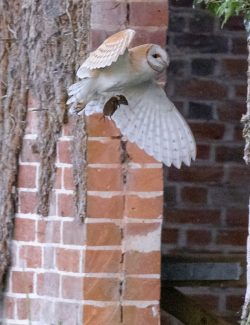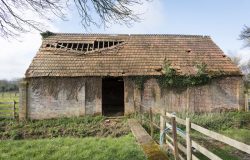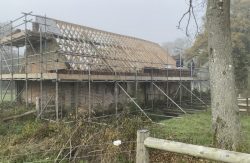 A TEAM of carpenters, tilers and scaffolders have rescued Bere Marsh Farm’s barn owls from winter homelessness in the nick of time.
A TEAM of carpenters, tilers and scaffolders have rescued Bere Marsh Farm’s barn owls from winter homelessness in the nick of time.
Just a few months after the Countryside Restoration Trust purchased the farm near Shillingstone, an appeal was launched to raise funds to repair the building which has been the barn owls’ home for almost 20 years. The work had to be done with great sensitivity so as not to dislodge the owls from the tumbledown barn. It was a race against time because of very short period between the completion of barn owls’ rearing of their chicks in autumn and the start of a new breeding cycle in early December.
Elaine Spencer-White, the manager of the CRT’s showcase property, says: “We are both relieved and delighted that the owls are now safe for many years to come. We could not have asked for a better repair team. Not only was their work superb but they had to do it within a very tight time frame and, most important of all, without upsetting or disturbing the resident male owl.
“They’ve even patched up his nesting box inside the barn which had become a bit dilapidated over the years. I think they developed quite a soft spot for him as he regularly flew around them while they were working.”
 There was a tight time-frame for the work to be done, and the CRT was only half-way to the necessary £30,000 for the new roof by the time the deadline arrived.
There was a tight time-frame for the work to be done, and the CRT was only half-way to the necessary £30,000 for the new roof by the time the deadline arrived.
“We took a deep breath and went ahead in the hope and belief that the huge affection in which the local community holds the owls would take us a lot nearer to our target,” says Elaine
Thanks to Knighton House School, joined by Bryanston and all the other schools in the Blandford Schools Network, a children’s poetry and performance competition, Icons in the Landscape, was launched in support of the owls. The appeal was also boosted by donations from several wildlife and conservation bodies, as well as individual contributions from CRT supporters and the local community
 Hayley Neal, CRT’s fundraising manager, says: “It was a tough call to proceed with the work when we did but we are glad we made it. The precious owls are now safe and we are confident that in the coming weeks we’ll reach our target.”
Hayley Neal, CRT’s fundraising manager, says: “It was a tough call to proceed with the work when we did but we are glad we made it. The precious owls are now safe and we are confident that in the coming weeks we’ll reach our target.”
Sam Watts, one of the two carpenters from Saxon Roofing Services who helped replace the rotten roof timbers on the barn, stressed how important it was to work sensitively and not disturb the resident male owl: “We had to be so careful so as not to unsettle him or frighten him from returning to his nest box in the barn every night. It was a bit nerve -wracking at first but eventually he got to know us and was curious about what we were doing.
“Without doubt this was the most exhilarating and challenging job I’ve worked on since becoming a carpenter. The male owl was just phenomenal to see flying so close to us whilst we were working. He’s got such a personality and it was a joy and privilege.”
 Barn owls are a key indicator species of a healthy eco-environment, and the Bere Marsh Farm birds are regularly spotted by walkers and cyclists using the trailways and paths across the 92-acre farm. Originally, the owls nested in the roofs of old barns and hollow trees but recent trends of modernising and converting barns into homes have severely reduced their natural habitats. Now up to 85 per cent nest and raise young in specially erected nest boxes. This made the restoration of the Bere Marsh barn even more important as it represents one of the few remaining settings in which the iconic species of the British countryside can be seen in its natural surroundings.
Barn owls are a key indicator species of a healthy eco-environment, and the Bere Marsh Farm birds are regularly spotted by walkers and cyclists using the trailways and paths across the 92-acre farm. Originally, the owls nested in the roofs of old barns and hollow trees but recent trends of modernising and converting barns into homes have severely reduced their natural habitats. Now up to 85 per cent nest and raise young in specially erected nest boxes. This made the restoration of the Bere Marsh barn even more important as it represents one of the few remaining settings in which the iconic species of the British countryside can be seen in its natural surroundings.
Photographs by Alan Wicks.